Skymark Airlines
|
| |||||||
| |||||||
| Founded | 12 November 1996 | ||||||
|---|---|---|---|---|---|---|---|
| Commenced operations | 19 September 1998 | ||||||
| Hubs | Haneda Airport | ||||||
| Focus cities |
Kobe Airport Naha Airport New Chitose Airport Fukuoka Airport | ||||||
| Fleet size | 26[1] | ||||||
| Destinations | 11[2] | ||||||
| Headquarters | Haneda Airport, Ōta, Tokyo, Japan | ||||||
| Key people | Masakazu Arimori (President and CEO) | ||||||
| Revenue |
| ||||||
| Operating income |
| ||||||
| Net income |
| ||||||
| Total assets |
| ||||||
| Total equity |
| ||||||
| Employees | 2,100 (June 2015)[5] | ||||||
| Website |
www | ||||||
Skymark Airlines Inc. (スカイマーク株式会社 Sukaimāku Kabushiki-gaisha) TYO: 9204 is a low-cost airline headquartered at Haneda Airport in Ōta, Tokyo, Japan,[5] operating scheduled passenger services within Japan. In addition to its base at Haneda, Skymark is the dominant carrier at Kobe Airport[6] and is the only domestic airline operating at Ibaraki Airport north of Tokyo.
Skymark was the first low-cost carrier established in Japan and is the only carrier offering domestic flights at Haneda Airport in competition with the duopoly of All Nippon Airways and Japan Airlines. Internet entrepreneur Shinichi Nishikubo controlled the company from 2003 to 2015, when the carrier filed for bankruptcy protection after attempting a fleet and service expansion. It remains the largest independent airline in Japan and the only independent low-cost carrier, as the other low-cost carriers in Japan are controlled by either ANA or JAL.[7] In August 2015, Skymark creditors agreed to restructure the airline under the control of Japanese private equity fund Integral Corporation (50.1%), with minority investments from All Nippon Airways (16.5%), Sumitomo Mitsui Banking Corporation and the Development Bank of Japan (33.4%).[8]
History
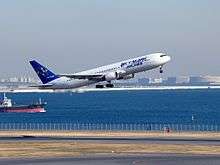
Skymark Airlines was founded in November 1996 as an independent domestic airline after deregulation of the Japanese airline industry and started operations on 19 September 1998.[5] It was originally owned by a consortium of investors led by the travel agency H.I.S. and headed by H.I.S. president Hideo Sawada;[9] another major early investor was the leasing company Orix. Its initial business plan called for it to be headquartered at Itami Airport in Osaka.[10] Takashi Ide, former head of British Airways' operation in Japan, was hired as the company's CEO in 1998.[11]
Skymark was able to obtain six slots at Haneda Airport in Tokyo in March 1997 and moved its headquarters to the Hamamatsucho district of Tokyo in March 1998. Its first scheduled flight from Haneda to Fukuoka was on September 19, 1998; it added routes from Itami to Fukuoka and Sapporo in 1999, but suspended these routes in 2000 in order to offer more frequencies on the Haneda-Fukuoka route.[12]
In 2002, Skymark took delivery of a third Boeing 767 aircraft and began service on the Haneda-Kagoshima route, as well as charter service from Haneda to Seoul. In 2003, with a fourth 767 dry-leased from All Nippon Airways, it began service to Aomori and Tokushima.[12]
The airline incurred considerable losses in its first few years of operations. It briefly considered a recapitalization led by Commerzbank but decided not to accept such an investment due to Air Do's issues with banks interfering in management. In August 2003, Sawada invited internet entrepreneur Shinichi Nishikubo to become Skymark's largest shareholder with a personal cash investment of 3.5 billion yen (having made around 9 billion yen from the IPO of his internet company in 2000).[9] Nishikubo took over as CEO in 2004, maintaining Ide as a "co-pilot" due to Ide's experience in the aviation industry.[11]
On 11 December 2003, Skymark announced that it expected a profit of 470 million yen for the half-fiscal year ending on 31 October, the first profit made since the airline began operations.[13] By using more efficient aircraft and systems developed in-house, Skymark attempted to undercut JAL and ANA on costs in order to offer lower fares.[14]
Skymark had a code sharing partnership with Japan Airlines starting with a Haneda-Osaka Kansai service in 2005-06,[12] and later on the Tokyo Haneda-Kobe route from Kobe Airport's opening in 2006.[15] JAL withdrew from Kobe in 2010, while Skymark developed Kobe into a secondary base.[16] Skymark purchased the naming rights for the Kobe Sports Park Baseball Stadium from 2005 to 2010.
Skymark announced in April 2010 that it would commence a "Narita Shuttle" service from Narita International Airport to Asahikawa, Sapporo, Fukuoka, and Okinawa in late 2011 and early 2012.[17]
Shift to premium service
In November 2010 Skymark announced negotiations with Airbus for an order of four Airbus A380 aircraft and two options, making it the first Japanese airline to order the type.[18][19][20] The airline announced its intent to use the aircraft on long-haul trunk routes out of Narita Airport such as London, Frankfurt, Paris and New York, and that they would be operated in a two-class, 394-seat configuration — with 114 seats in business class and 280 in a premium economy class.[21] Nishikubo envisioned an unheard-of fully-flat product in economy class, which the Skymark team calculated would break even at a one-way fare of 100,000 yen.[11]
As Skymark began to prepare for international service, it began to face stiff competition from a new group of low-cost carriers in Japan beginning in 2012, particularly from AirAsia Japan (later Vanilla Air) and Jetstar Japan at its Narita base. This led to a reduction in Skymark's frequencies on highly contested routes such as Narita-Sapporo and Narita-Fukuoka, and a refocusing of aircraft on more exclusive routes such as Narita-Ishigaki.[22]
Skymark attempted a more competitive domestic offering by executing leases for seven Airbus A330-300 aircraft in July 2012.[23] Skymark announced that it would outfit these aircraft in a 271-seat single-class premium configuration with 38-inch seat pitch and 22-inch seat width, tentatively called "Green Seats" and comparable to the domestic "Class J" offering on Japan Airlines,[24] to win market share among business travelers on the key domestic trunk routes from Tokyo to Fukuoka and Sapporo.[25] Skymark also had plans to install "Green Seat" cabins on its 737 fleet to create a 2-class configuration[26] but cancelled the plan in early 2014 in favor of keeping a single-class 737 fleet for competition with other LCCs.[27]
Somewhat controversially, Skymark announced that A330 flight attendants would wear miniskirt uniforms, in contrast to Skymark's usual polo shirt uniforms, for the first six months of operation of each route.[28] The Japan Federation of Cabin Attendants publicly complained about the idea, claiming that the uniforms were unsafe to the women wearing them and would lead to harassment and objectification.[29]
Since 2013, Delta Air Lines has been highly interested in beginning a code-share agreement with Skymark. This is mainly due to Delta's expanding Tokyo service. [30] After ANA's investment in Skymark, the possibility is now more slim. [31]
Financial downturn
Skymark's finances were hit hard by foreign exchange rate fluctuations. In February 2011, when Skymark placed its initial A380 order, the Japanese yen was trading at historically high levels of around 82 yen to the U.S. dollar. After the introduction of the Abenomics policy in late 2012, the yen plunged in value, reaching around 102 yen to the dollar in early 2015. Many of Skymark's major investments and expenses were denominated in dollars—including the A380 orders, the A330 leases and its fuel costs—while its domestic ticket revenue was in yen, and the airline did not engage in exchange rate hedging.[32] Skymark recorded its first net loss in five years for the fiscal year ended March 2014.[14]
In early February 2014, Skymark announced that it would downsize the Narita operation to only three destinations (Sapporo, Yonago and Okinawa). Nishikubo stated that the base lost money in every month except August and that all LCCs were under pressure there. He also expressed some reservations about the A330 fleet plan, stating that while the airline had funding in place for the first two aircraft, the third and subsequent deliveries could be impacted by the performance of Skymark's domestic operation as well as the success of its initial international service. Skymark planned to re-deploy 737s from the Narita and Haneda bases for charter services to destinations such as Guam.[33]
Airbus completed Skymark's first A380 in April 2014 and sent the aircraft to Germany for cabin installation.[34] In May, Skymark requested to reschedule a meeting with a European bank involved in financing of its A380 order. Airbus interpreted this as a signal that Skymark sought to renegotiate the contract, and sent a team of financial advisors to Skymark's head office in June. After a week of meetings, they proposed an amendment of the A380 purchase agreement, with the condition that if Skymark did not meet a certain revenue target, Nishikubo would be required to sell his shares to an outside investor chosen by Airbus. Nishikubo rejected this proposal in early July, believing there was a significant chance that Skymark would miss the target.[35]
In late July, Airbus announced that it had terminated the airline A380 order's, citing concerns over the airline's ability to fund the purchase in light of its poor financial performance. Nishikubo complained the airline was not given the opportunity to revise the contract, but simply received a fax notifying it of the termination.[36] After further negotiations, Airbus sued Skymark for damages in a London court; it was reported that Skymark had already paid Airbus 26.5 billion yen for the aircraft and could face up to 70 billion yen in penalties.[34]
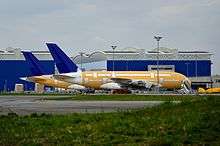

Skymark's A330s entered service on the Haneda-Fukuoka route in June 2014, but the additional seat capacity depressed Skymark's load factors on the route. Although Skymark's 737s were booked to more than 80% of capacity up to May 2014, the much larger A330s were only booked at 67% of capacity as of December 2014, while ANA or JAL achieved similar load factors with much higher-capacity aircraft. In an attempt to raise revenue, Skymark raised advance purchase fares on the route by 23% in October, bringing them closer to the level of JAL and ANA and further harming the competitiveness of the service.[37]
As the Airbus dispute lingered, Skymark pursued new sources of cash. It announced in November 2014 that it was exploring a cooperative relationship with Japan Airlines under which Skymark's 36 daily round trips to and from Haneda Airport would be code shared with JAL, subject to approval by the Ministry of Land, Infrastructure and Transport.[38] Skymark initially pursued JAL due to a perception that JAL could not threaten Skymark's independence; the terms of JAL's bankruptcy restructuring prevented it from making an investment in Skymark. However, the Japanese government pressed Skymark to make the codeshare trilateral with both JAL and ANA, reflecting the ruling Liberal Democratic Party's preference for ANA. Skymark also attempted a sale and leaseback of over 1 billion yen in equipment as a cash-raising measure, negotiating with a JAL-affiliated trading company and then with an ANA-affiliated trading company. In January 2015, ANA refused to provide financial support to Skymark, and several investment funds also balked at the prospect of injecting cash into the company.[39]
Bankruptcy
Skymark filed for bankruptcy protection under the Corporate Rehabilitation Law (which is equivalent to a Chapter 11 bankruptcy in the United States of America or an administration in the United Kingdom) at the Tokyo District Court in January 2015 after reporting ¥71 billion (or $571.3 million) in liabilities. It announced that Nishikubo would step down as CEO and would be replaced by CFO Masakazu Arimori.[34] Skymark announced that the A330s would be withdrawn from operation in March, and that various services to Okinawa and Kyushu would be eliminated. In an attempt to regain price competitiveness, Skymark introduced a fare of ¥8,000 on the Haneda-Fukuoka route, 1,800 cheaper than the next cheapest competitor, StarFlyer.[37] Skymark was approached by several potential sponsors early in its bankruptcy proceedings, including ANA, AirAsia, Delta Air Lines and American Airlines.[40]
Skymark's restructuring plan, submitted to the court in May, called for turnaround sponsor Japanese private equity fund Integral to own 50.1% of the recapitalized company, ANA to own 16.5%, and the remainder 33.4% to be owned by an investment fund controlled by government-affiliated Development Bank of Japan and Sumitomo Mitsui Banking Corporation, with Integral providing the new chairman, DBJ providing the new CEO, and code sharing between Skymark and ANA.[41] [42]
Intrepid Aviation and Airbus, who together held around two-thirds of Skymark's debt, opposed the plan, and Intrepid submitted a competing plan which called for another (unspecified) airline to sponsor Skymark's restructuring.[43] Intrepid reportedly approached several foreign airlines seeking support for this alternative plan.[44]
In the final creditor vote on August 6, 2015, the plan supported by ANA and Integral defeated a competing plan supported by Intrepid and Delta. The Delta plan was initially assumed to be the front runner based on Airbus's closer relationship with Delta, but Airbus ultimately switched sides and supported the ANA plan. The Nihon Keizai Shimbun reported that ANA made a conditional offer in late July to purchase Airbus aircraft, which Delta did not match by a prescribed midnight deadline, leading Airbus to switch its stance on the restructuring.[45]
During the restructuring, Integral management announced plans to change the airline's name to "Sky Bee" with a new logo in the form of a hornet. Another brand is considered such as Nok Air or other airline that agreed to purchased Skymark. Integral announced in August that it had no plans to change the name of Skymark, However It can be rebranded, but that the logo change remained under consideration with title included Japan. Also, Skymark announced that it will replace Kobe-Tokyo Haneda route by Osaka Itami-Tokyo Haneda route by January 2016. [46]
Destinations
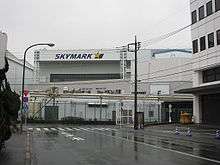
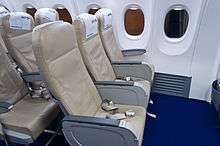
Skymark Airlines has operated scheduled flights to the following destinations:[2][12]
| Country | City | Airport | Notes |
|---|---|---|---|
| Japan | Amami | Amami Airport | Terminated |
| Japan | Aomori | Aomori Airport | Terminated |
| Japan | Asahikawa | Asahikawa Airport | Terminated |
| Japan | Fukuoka | Fukuoka Airport | Base |
| Japan | Ibaraki | Ibaraki Airport | |
| Japan | Ishigaki | New Ishigaki Airport | Terminated |
| Japan | Kagoshima | Kagoshima Airport | |
| Japan | Kitakyushu | Kitakyushu Airport | Terminated |
| Japan | Kobe | Kobe Airport | Base |
| Japan | Kumamoto | Kumamoto Airport | Terminated |
| Japan | Miyako | Miyako Airport | Terminated |
| Japan | Nagasaki | Nagasaki Airport | |
| Japan | Nagoya | Chubu Centrair International Airport | |
| Japan | Naha | Naha Airport | Base |
| Japan | Osaka | Kansai International Airport | Terminated |
| Japan | Osaka | Osaka International Airport | Terminated |
| Japan | Sapporo | New Chitose Airport | Base |
| Japan | Sendai | Sendai Airport | Terminated |
| Japan | Tokushima | Tokushima Airport | Terminated |
| Japan | Tokyo | Haneda International Airport | Base |
| Japan | Tokyo | Narita International Airport | Terminated |
| Japan | Yonago | Miho-Yonago Airport | Terminated |
Fleet

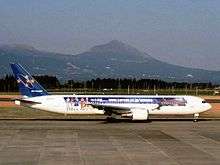
Current Fleets
The Skymark Airlines fleet consists of the following aircraft (as of August 2016):[47]
| Aircraft | In Service | Orders | Passengers | Notes | |
|---|---|---|---|---|---|
| Y | Total | ||||
| Boeing 737-800 | 26 | 0 | 177 | 177 | |
| Total | 26 | 0 | |||
Retired Fleets
| Aircraft | Total | Introduced | Retired | Notes |
|---|---|---|---|---|
| Airbus A330-300 | 5 | 2014 | 2015 | Disposed to Air Europa and Turkish Airlines |
| Boeing 767-200 | 1 | 2003 | 2004 | Leased from All Nippon Airways |
| Boeing 767-300ER | 6 | 1998 | 2009 | |
Previously, Skymark operated seven Boeing 767-200 and Boeing 767-300 widebody aircraft between 1998 and 2005. Some 767 fuselages were painted in special "billboard" liveries advertising third party companies, including Yahoo Japan,[48] Microsoft[49] and USEN.[50] The six 767s acquired by Skymark carried registrations JA767A to JA767F; the seventh, JA8255, was leased from All Nippon Airways from 2003 to 2004.[12]
Under Nishikubo, Skymark began acquiring new Boeing 737-800 narrowbody aircraft in 2005 and eventually retired the 767 from its fleet in 2009.[51]
Skymark ceased flying the A330 and most of the 737 during its bankruptcy in 2015.[52] All A380 orders from Skymark were rescinded as well, although All Nippon Airways will take 3 of the 5 original orders. Emirates will take up the 2 remaining already built Skymark A380s that were in long term storage.
Frequent flyer program
Skymark planned to introduce a frequent flyer program in January 2014 to coincide with the launch of its premium domestic service.[24] They delayed as of December 2013 to focus on preparing for international service in December 2014.[53] Skymark has provided award seats to members of the Delta Air Lines SkyMiles program since June 2011.[54]
References
- ↑ "Skymark Airlines fleet". Airfleets.net. Retrieved 4 June 2015.
- 1 2 "Airport Guide". Skymark Airlines. Retrieved 4 June 2015.
- 1 2 3 "2014年3月期 決算説明会" (PDF). Skymark Airlines. Retrieved 29 January 2015.
- 1 2 "平成27年3月期 第3四半期決算短信〔日本基準〕(非連結)" (PDF). Skymark Airlines. 12 February 2015. Retrieved 4 June 2015.
- 1 2 3 "About Us". Skymark Airlines. Retrieved 4 June 2015.
- ↑ "神戸空港利用状況(H23....5月)" (PDF). Retrieved 31 July 2013.
- ↑ Inagaki, Kana (2 February 2015). "Japan’s Skymark undone by ‘reckless’ expansion". Financial Times. Retrieved 4 June 2015.
- ↑ Fujikawa, Megumi (6 August 2015). "Skymark Creditors Reject Delta, Opt for ANA-Backed Funding Plan". Wall Street Journal. Retrieved 7 August 2015.
- 1 2 立木, 奈美 (24 September 2003). "スカイマーク救済の舞台裏/35億円を個人出資した西久保愼一氏の真意". Nikkei BP. Retrieved 9 December 2013.
- ↑ Lewis, Paul (27 November 1996). "Japan's Skymark will be launched in 1998". Flight International. Retrieved 4 June 2015.
- 1 2 3 "迷走スカイマーク 最後の証言者「第三極は消えず」". The Nikkei. 5 October 2015. Retrieved 5 October 2015.
- 1 2 3 4 5 "企業活動沿革". Skymark Airlines. Retrieved 4 June 2015.
- ↑ "Skymark Airlines Expects First Profits on Half-Year Basis.". Highbeam. 11 December 2003. Archived from the original on 11 June 2011. Retrieved 11 June 2011.
- 1 2 "スカイマーク再生法、拡大裏目 「共同運航」間に合わず". Nihon Keizai Shimbun. 29 January 2015. Retrieved 29 January 2015.
- ↑ "New Domestic Airports To Boost JAL’s Domestic Network". Japan Airlines. 30 January 2006. Retrieved 12 December 2013.
- ↑ "Skymark #3 in Japanese domestic market; new routes focus on developing Kobe as hub". anna.aero. 8 January 2010. Retrieved 12 December 2013.
- ↑ "[プレスリリース:「成田シャトル」構想を発表 成田−旭川・札幌(新千歳)・那覇・福岡まで980円より]". Skymark.co.jp. Retrieved 11 June 2011.
- ↑ "Skymark A380 press release" (PDF). Retrieved 4 August 2012.
- ↑ 2 August 2012. "Airbus press release regarding Skymark A380 Memorandum of Understanding". Airbus.com. Retrieved 4 August 2012.
- ↑ "UPDATE 2-Skymark Airlines orders Japan's first Airbus A380s". Reuters. 8 November 2010. Retrieved 8 November 2010.
- ↑ "Skymark May Order 15 Airbus A380s in International Expansion". Bloomberg. 12 November 2010. Retrieved 16 November 2010.
- ↑ "スカイマークがLCC対抗策 高級席導入・競合路線減便". 日本経済新聞. 19 July 2013. Retrieved 19 July 2013.
- ↑ "INTREPID LEASES SEVEN AIRBUS A330-300 AIRCRAFT TO SKYMARK AIRLINES". Retrieved 8 July 2013.
- 1 2 Yoshikawa, Tadayuki (20 June 2013). "スカイマーク、マイル導入へ 14年1月から". Aviationwire.jp. Retrieved 17 July 2013.
- ↑ "スカイマークが全席プレミアムシート機 来春、羽田発着の幹線に". Nihon Keizai Shimbun. 12 June 2013. Retrieved 8 July 2013.
- ↑ Yoshikawa, Tadayuki (11 June 2013). "スカイマーク、A330は上級「グリーンシート」のみ 737は2クラスへ". Aviationwire.jp. Retrieved 17 July 2013.
- ↑ "スカイマーク、737型機の改装見送り 低価格路線を維持". 日本経済新聞. 12 January 2014. Retrieved 13 January 2014.
- ↑ Yoshikawa, Tadayuki (12 December 2013). "スカイマーク、ミニスカ新制服で若さ強調 A330導入キャンペーン". Aviation Wire. Retrieved 12 December 2013.
- ↑ Nagata, Kazuaki (10 March 2014). "Skymark’s new uniform riles cabin attendants". The Japan Times. Retrieved 29 January 2015.
- ↑ https://www.reuters.com/article/2015/07/13/us-delta-air-lines-skymark-airlines-idUSKCN0PN2L420150713
- ↑ http://centreforaviation.com/analysis/delta-air-lines-seeks-a-tokyo-haneda-base-skymark-a-potential-partner-to-shake-up-alliances-121506
- ↑ Yoshikawa, Tadayuki (30 January 2015). "A330導入「会社設立並みに大変だった」 スカイマーク、737一本化で原点回帰". Aviation Wire. Retrieved 3 February 2015.
- ↑ Yoshikawa, Tadayuki (3 February 2014). "スカイマーク、余剰737はチャーター活用 成田縮小、羽田は増便". Aviation Wire. Retrieved 3 February 2014.
- 1 2 3 Matsuda, Kiyotaka (28 January 2015). "Skymark Files for Bankruptcy After Failed Airbus A380 Deal". Bloomberg Business. Retrieved 29 January 2015.
- ↑ "スカイマーク破綻 隠れたままの債務". Nihon Keizai Shimbun. 12 February 2015. Retrieved 12 February 2015.
- ↑ "Deal called off for delivery of Airbus A380 to Japanese airliner". The Japan News.Net. Retrieved 29 July 2014.
- 1 2 "スカイマーク、ドル箱路線が足かせに 羽田―福岡". Nihon Keizai Shimbun. 30 January 2015. Retrieved 3 February 2015.
- ↑ "羽田陣取り、雲の中 「スカイマーク・日航」に国交相慎重". Nihon Keizai Shimbun. 26 November 2014. Retrieved 28 November 2014.
- ↑ "Airline pays high price for independence". Nikkei Asian Review. 30 January 2015. Retrieved 30 January 2015.
- ↑ "Domestic, foreign airlines eyeing tie-up with Skymark". Nikkei Asian Review. 24 February 2015. Retrieved 24 February 2015.
- ↑ "Skymark to give court rehab plan as talks continue with creditors". Nikkei Asian Review. Nikkei. 29 May 2015. Retrieved 29 May 2015.
- ↑ "Skymark launches new management team as it implements turnaround plan". The Japan Times. 29 September 2015.
- ↑ Shiraki, Maki (1 June 2015). "Skymark's top creditor says looking for sponsor other than ANA". Reuters. Retrieved 3 June 2015.
- ↑ "Intrepid seeking sponsors for Skymark restructuring plan". Nikkei Asian Review. Nikkei. 5 June 2015. Retrieved 5 June 2015.
- ↑ "Delta outmaneuvered: ANA turned tables at last minute by making Airbus a deal". Nikkei Asian Review. 6 August 2015. Retrieved 6 August 2015. See also Cooper, Chris; Matsuda, Kiyotaka (5 August 2015). "Skymark Lenders Approve Rehabilitation Plan Backed by ANA". Bloomberg Business. Retrieved 6 August 2015.
- ↑ Yoshikawa, Tadayuki (5 August 2015). "スカイマーク、社名変更せず再建へ 佐山代表「変えると思ってやってない」". Aviation Wire. Retrieved 6 August 2015.
- ↑ "Global Airline Guide 2016 (Part One)". Airliner World (October 2016): 18.
- ↑ "Photos: Boeing 767-3Q8/ER Aircraft Pictures". Airliners.net. 20 October 2000. Retrieved 11 January 2013.
- ↑ "Photos: Boeing 767-3Q8/ER Aircraft Pictures". Airliners.net. 13 December 1998. Retrieved 11 June 2011.
- ↑ "Photos: Boeing 767-3Q8/ER Aircraft Pictures". Airliners.net. 7 December 2002. Retrieved 11 June 2011.
- ↑ "Skymark Airlines former fleet at". Airfleets.net. Retrieved 4 August 2012.
- ↑ Skymark stops flying A330
- ↑ Yoshikawa, Tadayuki (8 December 2013). "スカイマーク、マイル導入を延期". Aviation Wire. Retrieved 9 December 2013.
- ↑ "[プレスリリース:スカイマーク デルタ航空 特典交換プログラムへの座席提供について". Skymark.co.jp. Retrieved 11 June 2011.
External links
| Wikimedia Commons has media related to Skymark Airlines. |
- Official website (in Japanese)
- Official website (in English)
- Skymark Airlines fleet